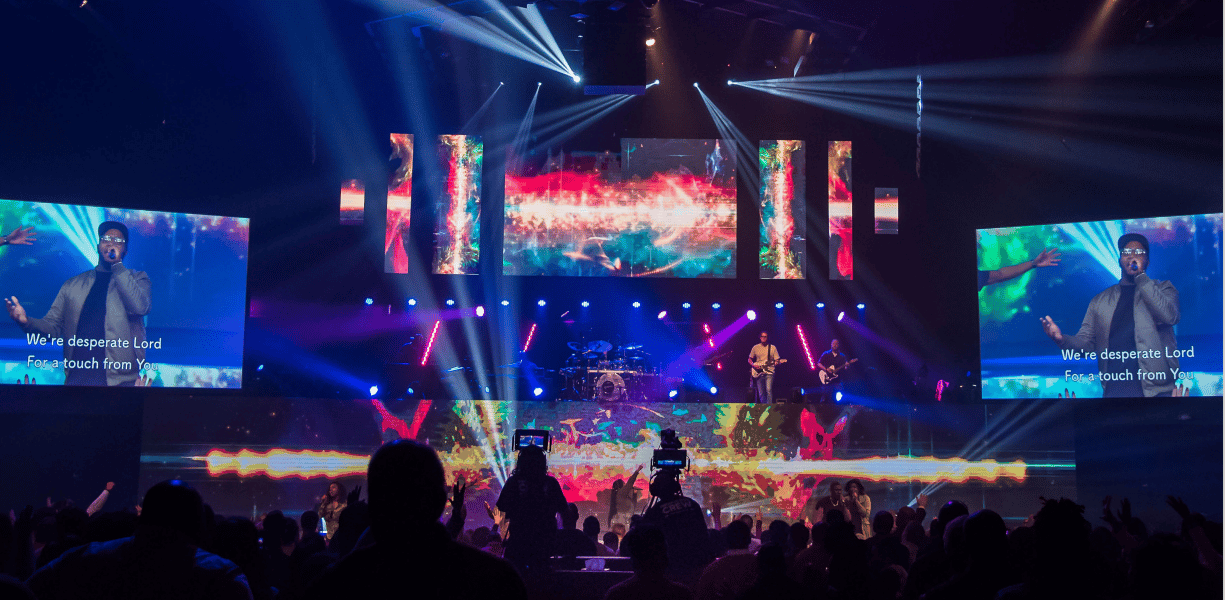By Jim Jensen, Sr.
Captivating new and existing members of a congregation will always remain a top priority and challenge for places of worship. Whether it’s due to illness, disabilities, time of year, global issues like the pandemic or personal choice, there are many factors that can cause attendance to fluctuate from week to week.
The advent of remote worship experiences allows people to be engaged and view services from virtually anywhere live or even on-demand. This not only helps ministries expand their reach but also connect with different groups of people they would not typically interact with.
While there are many benefits of online worship, in-person worship is unique because the space gives people a place to relax from the busyness of everyday life and bond with likeminded people in a safe, inviting atmosphere. The best way to engage congregants, whether in-person or virtual, is in an immersive, meaningful worship experience using audiovisual (AV) technologies.
Captivating Guests with AV Technology
Attracting attendees, new and existing, is no easy feat. In today’s digital age, places of worship are adopting new technologies like pan-tilt-zoom (PTZ) cameras, large displays, projectors, microphones and more to make services more creative, interactive and engaging for guests of all ages. When people feel engrossed in a service, they can form an emotional connection to the messages and a lasting relationship with other members and the church itself.
AV technologies work in unison with each other to project and stream crisp, clear visuals in real-time, capturing each and every angle of a speaker, choir, worship band or audience to completely transform a sermon into an impactful experience.
Here are a few ways that houses of worship can use AV to elevate their services for both in-person and virtual viewers, as well as some tips on what to look out for when adopting AV technology.
- Capture meaningful moments: A picture is worth a thousand words. But what about video? Once-in-a-lifetime moments of laughter, smiles and praise are worth hundreds of thousands of words. One of the most critical aspects of creating an immersive worship experience is capturing as many of these special moments as possible, not to mention doing so with precision and grace.
Capturing the full experience can be challenging for many reasons. For one, the size and existing architecture of a place of worship can greatly affect the type and amount of cameras needed to properly equip the space. It’s important to incorporate different types of camera technology that encapsulate the experience and offer different views to guests and virtual viewers.
PTZ cameras can be mounted on high ceilings, positioned hanging upside down or simply stationary on a tripod in the center of a room to capture all aspects of the environment from the speaker and choir to action shots of guests. Whether you prefer the front or back row at a service, or watching virtually, this gives all viewers a close-up perspective to the different emotions and reactions occurring in real-time.
While PTZs are traditionally used for recording and streaming services, they can also tape other events including weddings, concerts and rehearsals. The quiet nature of the cameras prevents any potential disturbances regardless of viewing location and reduce outside noises, like the rustling of paper or sidebar conversations.
- Create a personalized atmosphere: No one church has the same shape, size or architecture —so the set-up of technology can vary from one church to another. Regardless of how a church is outfitted with technology, you’ll want to select products that work in unison to build an immersive atmosphere.
Different AV technologies — like cameras, audio, lighting and displays — can magnify the worship service. Microphones ensure that whether you’re at the front or back of the church, or listening virtually, the sound is crisp and clear. Wireless microphones and receivers allow speakers to move around the room freely without compromising audio quality. If your congregation is large, multiple microphones can be connected at once to enable several people or choir members to speak, sing or pray.
Places of worship can integrate lighting and audio to mirror each other and create a somber or joyous experience. During prayer, a tech team can sync the lighting to automatically dim to fit the mood and environment. Lighting can also be used to bring added excitement and energy to a space in song or during a sermon.
Depending on your particular environment, displays can show up in small or large scales across different areas of the church, from the sanctuary to the lobby, to make people feel like they have a front row seat no matter where they’re located. They can even be aligned to fit a large stage or spliced into smaller digital walls across the worship campus.
When investing in technology, it’s important for organizations to seek out applications that can not only be used in coordination to improve the overall experience but be seamlessly integrated into a place of worship. Technology that’s easy to use and simplifies setup and production needs is helpful to volunteers or church staff, especially for those who may not be as tech savvy.
- Seek out advanced capabilities: In today’s digital age, you don’t have to seek out the biggest and most expensive technology for the best production quality. 4K and HDR resolution are now available on small, compact PTZs at affordable prices.
Due to the scalability of PTZs, they can fit many different environments, both low and high end, and make streaming extremely simple with plug-and-play capabilities. For larger churches that manage multiple streams, PTZs are easily integrated with video production systems to help manage a number of screens at once.
The Future of the Digital Church
As the digital church continues to grow in popularity and offer unique benefits to worship centers across the world, AV technologies will be at the forefront of creating immersive experiences to help congregations reach people in new, creative and effective ways.
Jim Jensen is the senior category owner for PTZ and remote systems at Panasonic Connect, a B2B company offering device hardware, software, and professional services for the connected enterprise, na.panasonic.com/us/panasonic-connect.
Photo courtesy of AE Global












